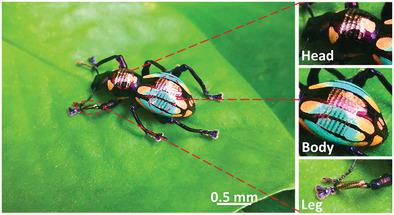Our official English website, www.x-mol.net, welcomes your feedback! (Note: you will need to create a separate account there.)
High‐Performance Full‐Photolithographic Top‐Contact Conformable Organic Transistors for Soft Electronics
Advanced Science ( IF 15.1 ) Pub Date : 2021-02-18 , DOI: 10.1002/advs.202004050 Xiaoli Zhao 1 , Shuya Wang 1 , Yanping Ni 1 , Yanhong Tong 1 , Qingxin Tang 1 , Yichun Liu 1
Advanced Science ( IF 15.1 ) Pub Date : 2021-02-18 , DOI: 10.1002/advs.202004050 Xiaoli Zhao 1 , Shuya Wang 1 , Yanping Ni 1 , Yanhong Tong 1 , Qingxin Tang 1 , Yichun Liu 1
Affiliation

|
Organic thin‐film transistors (OTFTs) are identified to be the most promising candidate for next‐generation wearable and implantable electronics because of their unique advantages including their flexibility, low cost, long‐term biocompatibility, and simple packaging. However, commercialization of organic transistors remains an enormous challenge due to their low mobility and lack of scalable strategy for high‐precise soft devices. Here, a novel photolithography fabrication strategy is proposed, which is completely compatible with various commercial organic semiconductor materials, for the first demonstration of the fully photolithographic top‐contact conformable OTFTs with the device density as high as 1523 transistors cm−2. Excellent electrical and mechanical properties with device yield as high as 100%, field‐effect mobility up to 1–2 cm2 V−1 s−1, and outstanding conformability are shown. This work provides a new strategy that can fully maximize the advantages of organic materials and photolithography technology, showing a great prospect in the development of high‐performance, high‐precise organic devices toward the commercialized and industrialized soft electronic products.
中文翻译:

适用于软电子产品的高性能全光刻顶接触适形有机晶体管
有机薄膜晶体管(OTFT)具有独特的优势,包括灵活性,低成本,长期生物相容性和简单包装,因此被认为是下一代可穿戴和可植入电子产品的最有希望的候选者。然而,由于有机晶体管的低迁移率和缺乏用于高精度软设备的可扩展策略,其商业化仍然是一个巨大的挑战。在此,提出了一种新颖的光刻制造策略,该工艺与各种商业有机半导体材料完全兼容,首次展示了器件密度高达1523晶体管cm -2的完全光刻的顶部接触适形OTFT。。显示了出色的电气和机械性能,器件的成品率高达100%,场效应迁移率高达1-2 cm 2 V -1 s -1,并且具有出色的一致性。这项工作提供了一种可以充分利用有机材料和光刻技术优势的新策略,在向工业化和工业化软电子产品发展高性能,高精度有机器件方面显示出广阔的前景。
更新日期:2021-02-18
中文翻译:

适用于软电子产品的高性能全光刻顶接触适形有机晶体管
有机薄膜晶体管(OTFT)具有独特的优势,包括灵活性,低成本,长期生物相容性和简单包装,因此被认为是下一代可穿戴和可植入电子产品的最有希望的候选者。然而,由于有机晶体管的低迁移率和缺乏用于高精度软设备的可扩展策略,其商业化仍然是一个巨大的挑战。在此,提出了一种新颖的光刻制造策略,该工艺与各种商业有机半导体材料完全兼容,首次展示了器件密度高达1523晶体管cm -2的完全光刻的顶部接触适形OTFT。。显示了出色的电气和机械性能,器件的成品率高达100%,场效应迁移率高达1-2 cm 2 V -1 s -1,并且具有出色的一致性。这项工作提供了一种可以充分利用有机材料和光刻技术优势的新策略,在向工业化和工业化软电子产品发展高性能,高精度有机器件方面显示出广阔的前景。


























 京公网安备 11010802027423号
京公网安备 11010802027423号